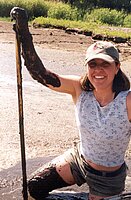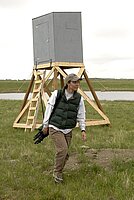Variables Influencing Habitat Use by Diving Water Birds Foraging in the Prairie Pothole Region

Shannon Torrence has a B.A. in Biology from Austin College, Texas with a minor in environmental studies. A Water Institute Fellowship supported her research in wetland ecology for her M.S. degree.
Shannon has plans to pursue a PhD degree at Texas Tech University. Her study will investigate the effects of land use (cropland vs. grassland) on amphibian populations in playa wetlands of the Southern High Plains. Malathion, a commonly used pesticide in this area, may cause immune deficiencies in amphibians, making them more susceptible to parasites. She also plans to publish some findings from her master’s work.
Shannon Torrence, investigating the habitat use of diving birds in the prairie potholes.
Fellow: Shannon Torrence, Department of Biological Sciences, NDSU
Advisor: Malcolm Butler, Professor of Biological Sciences, NDSU
Matching Support: Delta Waterfowl and Wetlands Research Foundation, and California Waterfowl Association through the Dennis G. Raveling Scholarship
Degree Progress: M.S., December 2002
Variables Influencing Habitat Use by Diving Water Birds Foraging in the Prairie Pothole Region
Torrence, Shannon Marie., M.S., Department of Biological Sciences, College of Science and Mathematics, North Dakota State University, December 2002, Variables Influencing Within- pothole Habitat Use by Diving Ducks Foraging in the Prairie Pothole Region. Major Professor: Dr. Malcolm G. Butler.What circumstances allow coexistence of similar species is a common but complex question in community ecology research. Sympatric species within the same guild must employ a mechanism of niche diversification in order to coexist. Niche separation may result from active competition when one species exploits or interferes with another’s ability to use resources. Conversely, if species employ a resource partitioning mechanism based on differential use of habitat, the structure of a guild may depend upon spatial heterogeneity. This would reduce the influence of competition.
I studied the guild structure of foraging diving ducks on the pothole scale in southwestern Manitoba. The goals of my study were to uncover patterns of habitat use by diving ducks foraging within potholes in relationship to water depth, submergent vegetation, benthic invertebrate biomass, abundance, and size, and benthic substrate compactness and particle size and, I also sought to explain observed patterns in habitat use by comparing habitat variables to morphological features of diving waterfowl species. I found that benthic particle size and compactness decrease with depth, and submergent plants tend to grow within certain depth zones. I found that while diving ducks forage at specific depths within potholes, most divers foraged shallowly. Because most divers forage shallowly, variation in dive locations cannot be explained by habitat variables measured, nor by invertebrate biomass, abundance, or size. However, depths where divers forage within potholes can change between years. When food resources are limiting, competition may be high at shallower depths, but diving ducks most likely forage opportunistically on patchily distributed invertebrate prey.
A copy of Shannon's thesis can be obtained from Prof. M.G. Butler.
Relevant Publications of K.D. Zimmer and the Butler Research Group
December 2000, 62nd Midwest Fish and Wildlife Conference Minneapolis, Mn., “Aquatic Invertebrates in Seasonal Forest Wetlands: Characteristics and Influences”
June 2001, North American Benthological Society 49th Annual Meeting. LaCrosse, WI., “Invertebrate Communities in Northern Forest Wetlands: Characteristics and Controls”.


Melcolm Butler
Biological Sciences
Office: Research 2, Room 214B
Phone: 701-231-7398
Email: malcolm.butler@ndsu.edu


